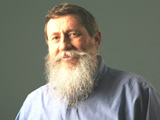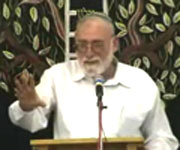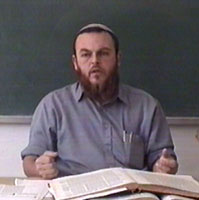Beit Midrash
- Library-Sifria
- Pninei Halacha
- Prayer
7. Those Accustomed to a Different Nusach
Sometimes the question arises regarding how a person should practice when his father, who is a member of one ethnic group, becomes accustomed to praying in a nusach of a different ethnic group. Should he pray in the nusach in which his father currently prays or in the nusach of his father’s ethnic group? As a general rule, the obligatory minhag is that of the ethnic group and not one’s father’s individual minhag. However, when the son prefers to continue in his father’s adopted nusach, or because he finds it difficult to change, or for any other reason, he is permitted to continue praying in his father’s nusach. Since this question poses implications on other issues, it is best that one consult with his rabbi on this matter.
A similar dilemma arose among members of Chassidic families, who learned in Lithuanian yeshivot and became accustomed to praying in Nusach Ashkenaz. When they left the yeshiva, they deliberated whether to continue praying in Nusach Ashkenaz as they were taught in yeshiva, or return to praying in Nusach Sephard-Chassidi, the minhag of their parents.
The rabbis of the Ashkenazic minhag taught that, in principle, they must continue praying in Nusach Ashkenaz, for in the past, all Ashkenazic Jews prayed in Nusach Ashkenaz, and only 200 years ago did the Chassidim change their nusach. Even though now, after such a long time, all Chassidim will not be instructed to return to pray in Nusach Ashkenaz, still, it is best that those Chassidim who already became accustomed to praying in Nusach Ashkenaz continue to pray that way, because it is their ancestors’ original nusach. However, the Chassidic rabbis insisted that they must continue in the Chassidic nusach, reasoning that since prominent Chassidic authorities have instructed those who prayed in Nusach Ashkenaz to switch to the Nusach Sephard-Chassidi, in congruence with the writings of the Ari, all the more so, anyone born into a Chassidic family must continue praying in the Chassidic nusach.
In practice, since there are differing opinions, the person posing the question may choose how to practice. Still, it is best to consult with one’s rabbi on this matter. 1
8. Ashkenazim Who Pray with a Sephardic Pronunciation
A similar question arose among Ashkenazic immigrants from the dati-leumi (national-religious) community. Approximately three generations ago, with the beginning of the gathering of the exiles, a need was felt to consolidate the Diaspora communities and to restore the Jewish nation to its Hebrew language. For unification purposes, the Sephardic pronunciation was chosen. Even though Maran HaRav Kook ztz"l, and many other poskim, are of the opinion that each ethnic group must preserve its own accent in prayer, in actuality, since the spoken Hebrew and the Hebrew learned in schools were in a Sephardic pronunciation, the Sephardic accent became imbedded in the prayer service too. Indeed, many leaders of national-religious educational institutions, acting in accordance with the rulings of a few rabbis, instructed their Ashkenazic students to pray with Sephardic pronunciation.
There are some rabbis who spoke strongly against the Ashkenazim who changed their accent. Some taught that even people who find it difficult to pronounce all the prayers in an Ashkenazic pronunciation should at the very least pronounce Hashem’s Name in that manner, because the pronunciation of Hashem’s Name in the Ashkenazic accent has greater grammatical advantages (Har Tzvi Orach Chaim 1:4; Az Nidberu, part 3, 48:1, according to the Chazon Ish).
However, in practice, most rabbis do not encourage their students to change their pronunciation. Since the Sephardic accent is just as acceptable as the Ashkenazic, and everyone is used to it, there is no obligation to return to one’s original accent. Moreover, if the effort to change one’s pronunciation will disrupt his kavanah in prayer, it is preferable not to change it. It is best that one who already prays in a Sephardic accent also say Hashem’s Name that way so as not to mix accents. There are even those who are concerned that one who combines accents b’dieved does not fulfill his obligation (Rav Yosef Henkin; She’arim Metzuyanim BaHalachah 18:5). Therefore, it is customary to recite the whole prayer service, including Hashem’s Name, in the Sephardic accent. 2
9. Members of Different Ethnic Groups Praying Together
In many places, members of all the different ethnic groups pray together. That is the accepted practice in many yeshivot, so as not to cause a daily schism between the students, as well as in small communities which do not have enough people for each group to maintain a large minyan to pray and learn Torah.
In the past, in order to refrain from disrupting the prayer service and creating separate minhagim within the same synagogue, the congregation would establish one nusach according to the majority (see Igrot Moshe, Orach Chaim, part 4, 34). However, in our society, where people are familiar with and accustomed to the different minhagim, in many places it is customary to give each ethnic group expression in the prayer service. Usually, the congregation follows the chazan. For example, if the chazan is Sephardic, he will pray in the Sephardic nusach, and if he is Ashkenazic, he will pray in the Ashkenazic nusach. There are places that even if the chazan is Yemenite, although his pronunciation varies greatly from the norm, he prays in his Yemenite dialect. Since all the minhagim are acceptable and known to all, there is no fear of "lo titgodedu," and it is not likely to incite controversy.
That is how we practice in Har Berachah. When there are major differences between the minhagim, it is our custom to follow the shorter nusach. For example, on "Bet-Hei-Bet" (fast days enacted on Monday and Thursdays by some ashkenazic authorities), when the Ashkenazim customarily say Selichot, we do not recite them communally, since the Sephardim do not follow this custom. Similarly, Shir HaShirim (Song of Songs) is not recited before Kabbalat Shabbat, though it is the minhag of many Sephardim. Likewise, we do not recite all the passages of the Korbanot (sacrificial offerings) out loud in the minyan, as is the Sephardic tradition. Those who wish to say them recite them individually before the prayer service. However, when the extension to the prayer service is not burdensome, the congregation follows the chazan; for instance, at the end of the prayer service, when the Sephardim prolong the recital of the Psalm of the Day and the Pitum HaKetoret, or the Tachanun of Mondays and Thursdays.
The Sephardic minhag is that the chazan recites all the Psalms and Birkot Keriat Shema out loud, in order to fulfill the obligation for a person who does not know how to read. Nevertheless, the prevalent custom is that even the Sephardic chazanim say only the conclusion of the mizmorim and berachot out loud. This is because nowadays everyone knows how to read, and the recital aloud prolongs the duration of the prayer service and disrupts the kavanah of some of the people praying.
As a general rule, regarding prayers recited out loud, the congregation follows the chazan, while concerning prayers recited silently, each person prays according to his individual minhag. Nonetheless, it is unnecessary to be meticulous concerning this, and one who wishes to pray in the chazan’s nusach is permitted to do so, for that is the opinion of some poskim. One who wishes to pray in his own nusach, even those passages recited aloud, is permitted to do so, as long as he says them quietly, so as not to disturb the congregation and accentuate the differences between him and the chazan.
When the Sephardic chazan recites the Thirteen Attributes of Mercy three times in the prayers of supplication (tachanunim) of Mondays and Thursdays, it is proper that the Ashkenazim follow along with him.
To conclude, in all these situations, in which the benefit to the community and to the prayer service are weighed against the preservation of nusachim, the mara d’atra, the primary rabbi of the place, must determine what is best.
^ 1.The position of the rabbis who pray in Nusach Ashkenaz is brought in Igrot Moshe, Orach Chaim, part 2, 24, as well as in Tefillah Kehilchatah, in the name of Rav Elyashiv. Their opinion is that Nusach Ashkenaz is the nusach in which it is proper for all Ashkenazim to pray. However, Rav Elyashiv adds in the next paragraph that one who has regularly prayed in a different nusach since he was born, and it is difficult for him to change, may continue praying in the nusach to which he has become accustomed, for that is what the Chazon Ish and Rabbi Yaakov Kanievsky have taught. The opinion of the Chassidic rabbis is widely known.
^ 2.Mishpatei Uziel, Orach Chaim 1, maintains that it is proper for all the ethnic groups to pray in a uniform nusach and accent. Maran HaRav Kook commented on this, saying that every ethnic group must preserve its own minhagim. He continues that one who changes his accent is considered like "one who recited [the Shema] and was not meticulous in enunciating the letters," for even though he fulfills his obligation, he should not do so l'chatchilah. That is the opinion of most rabbis, among them Minchat Yitzchak 3:9, and 4:47, 4, and Az Nidberu, part 3, 48:1. However, a number of Sephardic rabbis, including Yaskil Avdi, part 2, Orach Chaim 3, and Yabia Omer, part 6, Orach Chaim 11, write that an Ashkenazi is permitted to switch to the Sephardic accent. They praise the Sephardic nusach and note that since it is spoken today in the Holy Land, it is therefore proper to pray in it. However, it is noteworthy that the spoken accent today is less precise than the original Sephardic accent, for today’s spoken accent does not differentiate between a tet and a taf, between a kuf and a kaf degushah, between a taf degushah and a taf refuyah, or between a kamatz and a patach. From a certain standpoint, it is the worst of all the pronunciations, for it does not have the virtues found in the Ashkenazic dialect, and it is missing a few of the advantages present in the Sephardic dialect. Nevertheless, Yabia Omer does not comment on this.
In any case, after people have already become accustomed to the Sephardic accent, even according to those who maintain that in principle one must revert to his family’s nusach, if it is difficult to do so, and it will disrupt one’s kavanah, one need not revert to the Ashkenazic nusach. That is what my teacher and rabbi, HaRav Tzvi Yehudah HaKohen Kook, ztz"l, maintained. Furthermore, he mentioned that there are things which are accepted by the community even though the Chachamim are not pleased with them. He also said that something good comes out of this: members of different ethnic groups can pray together, and unity is increased.
The Yabia Omer 11:6, quotes Rabbi Unterman, the Ashkenazic Chief Rabbi of Israel, in saying that the Ashkenazim who became accustomed to praying in the Sephardic accent should not be compelled to revert to the Ashkenazic pronunciation. That is how they were educated and they are comfortable in this accent, because it is widespread throughout the whole country. The Yabia Omer adds that it is preferable that they pray in the spoken dialect, for in that way the youth will feel more of a sense of belonging to the synagogue and the prayer service. One may add that even if a person stands before a king, he will talk in the accepted dialect, and he will not begin to precisely pronounce the letters. We learn many of the laws of prayer from an individual who stands before a king using the kal vachomer principle.























